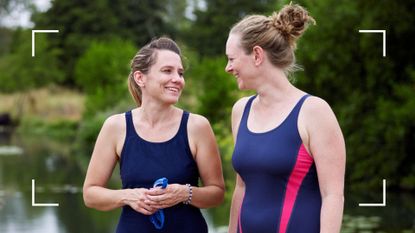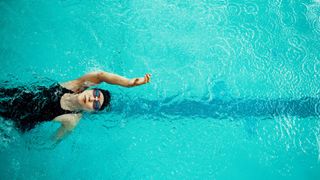How to learn to swim as an adult: Six simple steps, according to coaches and instructors
Want to know how to learn to swim as an adult? We chatted to three swim coaches who offered their advice


If you're looking to learn how to learn to swim as an adult, you're not the only one. Swimming has long held a reputation for being one of the hardest activities to master, especially for those who fear water or struggle with body image.
While many people were taught how to swim as children, it entirely depends on where, when, and how you grew up as to whether you got the chance to learn. And even if you did start to learn, bad experiences in the water take many people out of the pool for good.
The widespread misinformation about how long it takes to learn to swim and the myth that the skill must be learned as a child, or never at all, has solidified many people's hesitation. As a result, millions of people in the UK today have been alienated from enjoying the benefits of swimming. But it doesn't have to stay this way. This is how to learn to swim as an adult, according to several swim coaches and instructors.
How to learn to swim as an adult
While learning how to swim as an adult might sound like a titanic challenge, the voyage doesn’t need to be an ordeal. Overcoming the fear of water and mastering strokes when you’re older is completely doable (and can even be exciting!) with the guidance of a qualified instructor. It can also introduce you to a whole host of previously inaccessible pleasures, such as enjoying the hotel pool or discovering the easiest and best ab workouts.
We spoke to several UK swimming instructors to get their best tips on how to learn to swim as an adult, no matter what age you are.
1. Find a certified instructor
Whether you’re five or fifty, it's always best to start learning how to swim under the guidance of a certified instructor.
A good teacher is crucial for ensuring water safety and helping you overcome nerves, especially if you’re a complete newbie. Not to mention, it’s always nice to have someone help push and motivate you.
Sign up for the woman&home newsletter
Sign up to our free daily email for the latest royal and entertainment news, interesting opinion, expert advice on styling and beauty trends, and no-nonsense guides to the health and wellness questions you want answered.
“Find a qualified swimming teacher and maybe have a 1-2-1 first to help overcome those initial fears,” says Sarah Porter, a Her Spirit swim coach with a Level 2 STA open water swimming qualification.

2. Stop overthinking it
It can be easy to overanalyze the process, but fixating on every move can make the experience more overwhelming than it needs to be. To ease the pressure on yourself, abandon any notions you have of becoming the next Dara Torres and simply focus on making friends with the water.
“It isn't as technical as people think,” swim coaches Cheryl and Ian Cross, of Swimming without Stress, explain. “It's really all about learning to trust and enjoy the support of the water, and then you need a few basic skills to give you access to greater distances and deeper water.”
3. Get comfortable in the water
For many beginners, it’s not the swimming itself that’s the obstacle - it’s the fear of losing control in the pool. Anxiety in the water is a sure-fire barrier to learning the skill, so it’s important to rinse any nerves out of you before tackling the strokes.
Cheryl and Ian’s approach, based on a technique called the Shaw method, addresses this issue by teaching the art of ‘rediscovering the natural balance and poise’ of the body in water. Once you understand that H20 can uplift you, rather than, well, drown you, dipping beneath the pool's surface becomes a whole lot less daunting.
“Start by getting your face in. Find a balanced position looking down into the water, without taking a deep breath, gently sing (aahhh) into the water, keeping your mouth open, and keep singing as you come out,” Ian says. “By doing this you're teaching your body not to panic. It soon becomes very calming and when you're comfortable with this, you've taken a very important step to becoming comfortable in water.”
Some of the best mindfulness apps also explore swimming and overcoming fears of the water, so this is something else to consider while you're learning.
Once you’ve found the right teacher and are reasonably comfortable in the pool, it’s time to be introduced to the four faces of swimming - also (more commonly) known as the strokes.

4. Learning the strokes
As you might already know, there are four main strokes in swimming - breaststroke, butterfly, backstroke, and front crawl (also called freestyle).
Breaststroke and butterfly are known as short-axis strokes, which means that the propulsion is derived from the hips, while backstroke and front crawl are long-axis strokes, meaning that they depend on the rotation of the body’s longitudinal axis (the line that runs from the head to the toes) to propel.
Nicole Martin, certified swim instructor, swimming teacher, lifeguard trainer, and owner of Core Aquatics emphasizes that there’s no ‘one rule’ for which stroke you should learn first, but many beginners find the back paddle, the gentle precursor to the slightly more forceful backstroke, the easiest to manage.
The technique involves floating on one’s back, kicking the legs in a crawl-like motion, and scrolling the hands by the hips. Once the student is comfortable with this, they can lift their arms out of the water to complete the backstroke.

Breaststroke, which involves kicking your legs outwards like a frog while your arms extend in semi-circular movements, is also a good stroke for beginners.
By allowing the swimmer to keep their head above the water at all times, this stroke is ideal for those who aren't fully comfortable with dunking their head just yet. It also enables the swimmer to get a grasp of their surroundings, making it easier for them to cross the pool without the fear of bumping into others or unexpectedly hitting a wall.
Despite backstroke and breaststroke being the most popular of the four strokes for beginners, they may not be the most suitable option for everyone who wants to know how to learn to swim.
“Some adults come after an operation and they can't swim a particular stroke,” Nicole explains. “One example is not being allowed [by their doctor] to swim breaststroke after surgery. The swimmer may only swim breaststroke! Other examples are pregnancy and previous traumatic experiences such as drowning.”
In summary, whatever stroke is easiest for you is the right one for you.
5. Be patient and practice, practice, practice
Unfortunately, there are no shortcuts to learning how to swim - just good old-fashioned patience and practice. Luckily, you'll get better at it over time and soon, you'll be off to explore the most amazing swimming pools in the world.
Adults who don’t have a fear of water or balancing issues may acquire the skill with less than 30 hours of lessons, while those battling anxiety or instability are likely to need a significantly longer timespan. The experience is different for everyone, so don’t beat yourself up if you learn at a slower rate than your fellow beginners.
“It really depends on the individual,” says Nicole, adding that her clients' "goals and [level of] attendance" also determine how long it takes them to learn to swim.
6. Invest in good swimwear
While you won’t need to splash out on anything fancy, a swimsuit and swim cap are nearly always required to gain access to public swimming pools. Whether you want to follow the swimwear trends for 2022 or select from a classic line-up of the best bathing suits is entirely up to you, but just make sure you're comfortable and can move freely with your final choice.
Goggles, although not enforced, are also hugely important for adequately completing the strokes. Nose clips and earplugs can be another nifty purchase to help keep water out of your nasal passages, especially if you’re prone to developing ear infections or sinus issues.
Flippers or fins are great for increasing speed and velocity in the water, but have also been banned in some public swimming pools due to their potentially hazardous nature. Be sure to check with the lifeguard on duty before buying a pair.
When it comes to getting out of the pool, investing in a pair of flipflops or sliders if you don't already have some is nearly always a good idea. Pool sides, even super clean ones, have the potential to spread bacteria.

Why should you learn how to swim?
Learning to swim is an essential life skill for anyone, adult or not, to pick up. First of all, much like riding a bike, it opens doors that we didn't even know existed.
It gives a new chance to socialize with friends, meet new friends or even help teach the younger generation something new. Not to mention, you could join the millions of adults in the UK who utilize the benefits of cold water swimming (7.5 million by Active Lives and Swim England's last count!)
There are also plenty of practical reasons why learning how to swim is a good idea. If you have kids or grandkids who love running into the swimming pool first thing on a holiday, it's important there's someone who can dive in after them. Going on a boat trip? While capsizes and sinkings are rare, they do happen, and being able to swim will mean you're more likely to be able to get to safety. Drowning, according to Stanford Children's Health, is still the most common cause of accidental death in children, more than falls and injury, so it is a life-saving skill.
If you want to know how to learn to swim as an adult, reach out to the communities near you:
- In the US: Find lessons and support for all ages, including specialized adult swimming courses, at SwimLabs.
- In the UK: Visit Better.org for information around adult swimming courses, or contact your local Everyone Active center.

Hailing from the lovely city of Dublin, Emma mainly covers the Royal Family and the entertainment world, as well as the occasional health and wellness feature. Always up for a good conversation, she has a passion for interviewing everyone from A-list celebrities to the local GP - or just about anyone who will chat to her, really.
Emma holds an MA in International Journalism from City, University of London, and a BA in English Literature from Trinity College Dublin.
-
 Recent weeks 'precious' for Kate Middleton with 'country walks and snuggles in front of the TV' with George, Charlotte and Louis
Recent weeks 'precious' for Kate Middleton with 'country walks and snuggles in front of the TV' with George, Charlotte and LouisThe Prince and Princess of Wales have been able to relish in precious family time over the Easter break, according to a royal expert
By Caitlin Elliott Published
-
 I put the EcoAir DC12 MK3 dehumidifier to the test – and found it's perfect for bedrooms
I put the EcoAir DC12 MK3 dehumidifier to the test – and found it's perfect for bedroomsThis quiet dehumidifier punches above its weight when it comes to performance and usability, and won't break the bank.
By Amy Cutmore Published